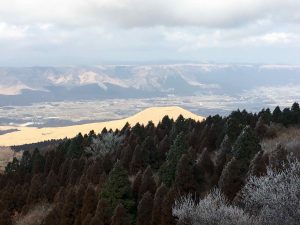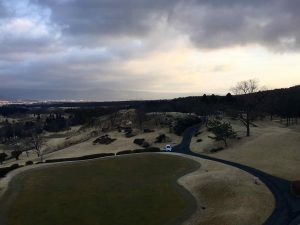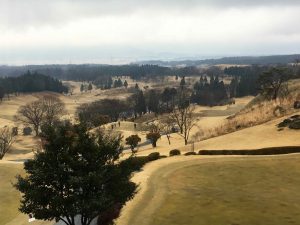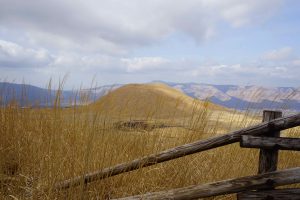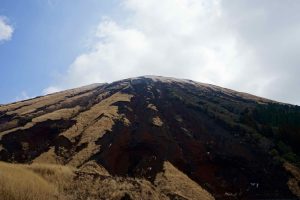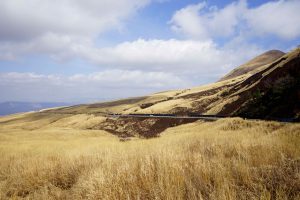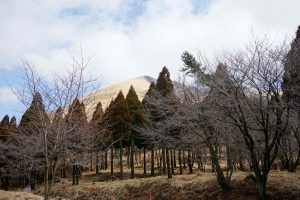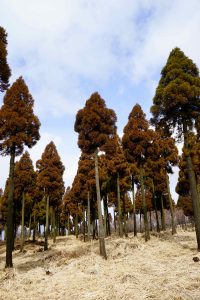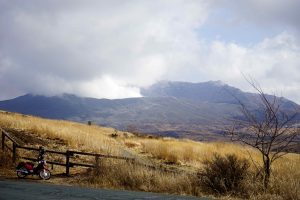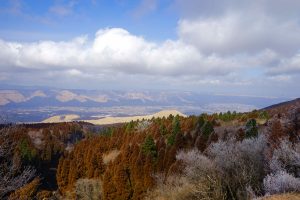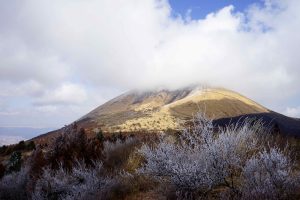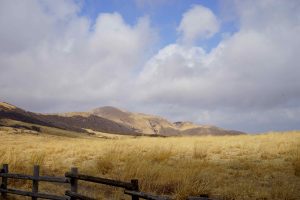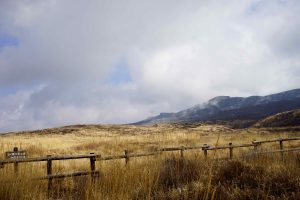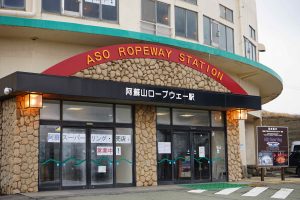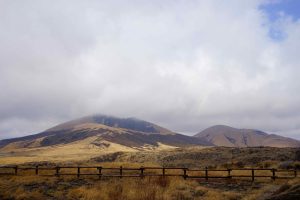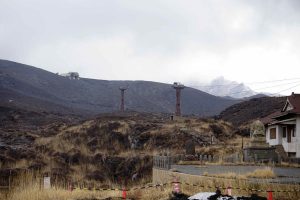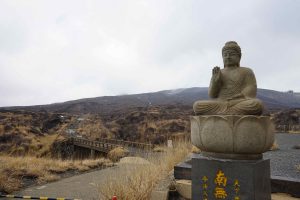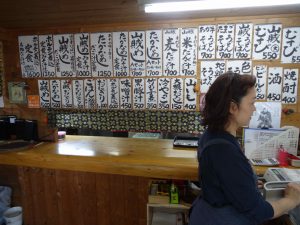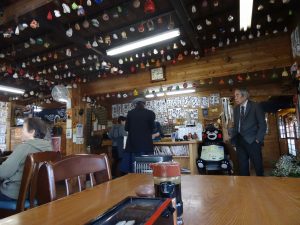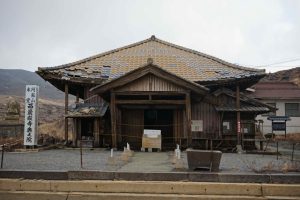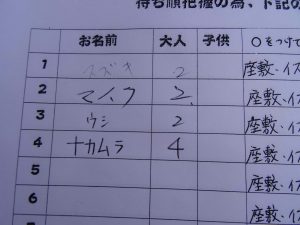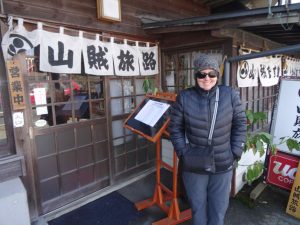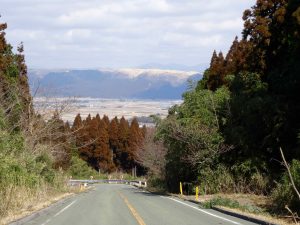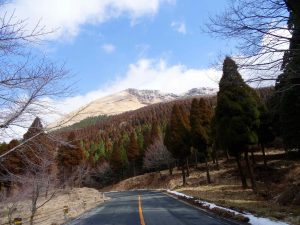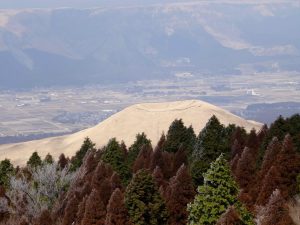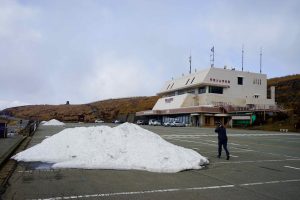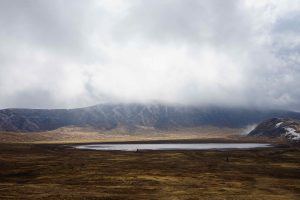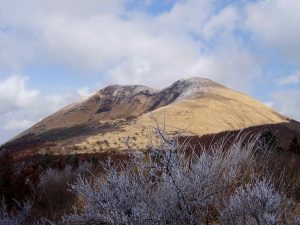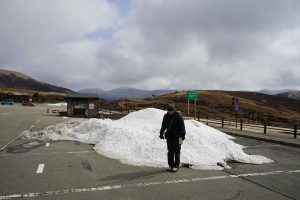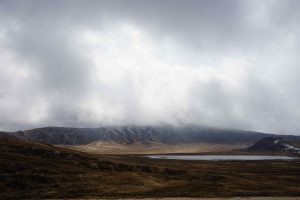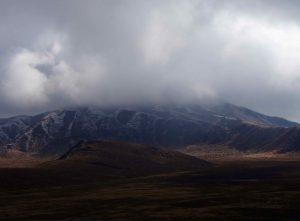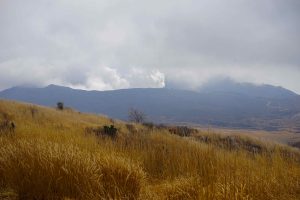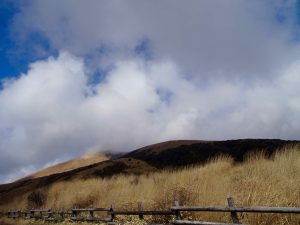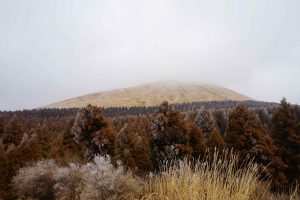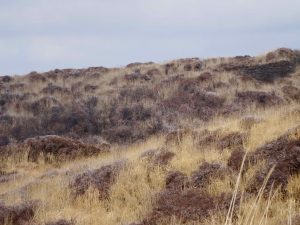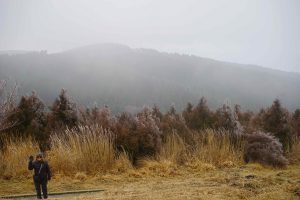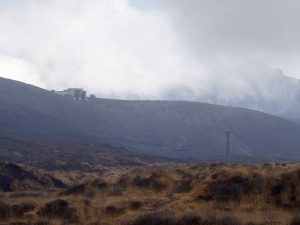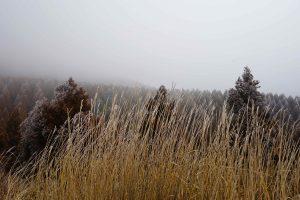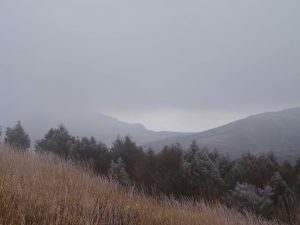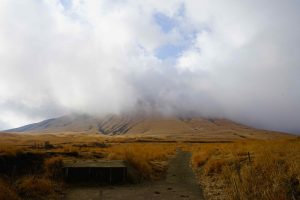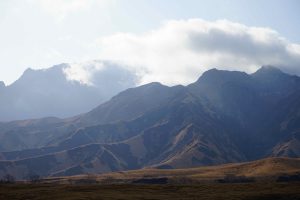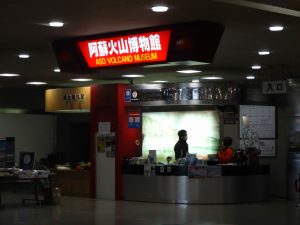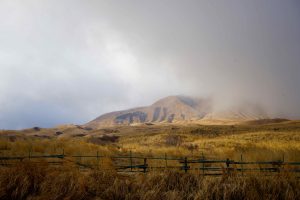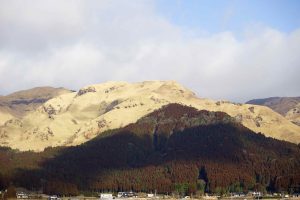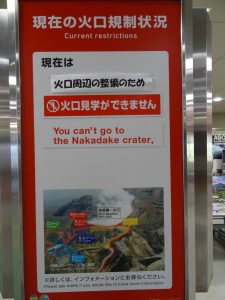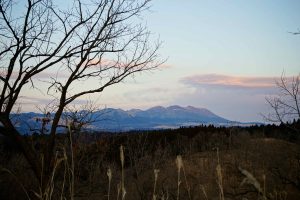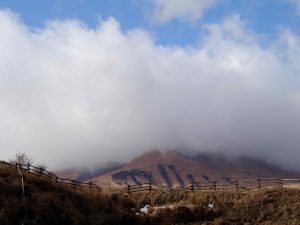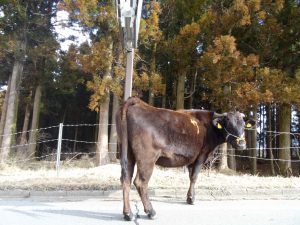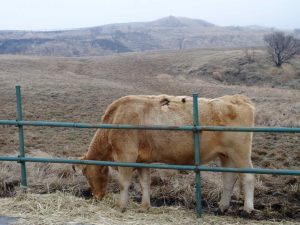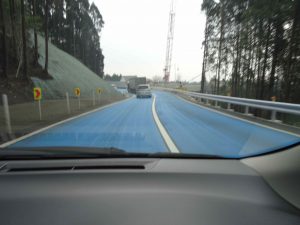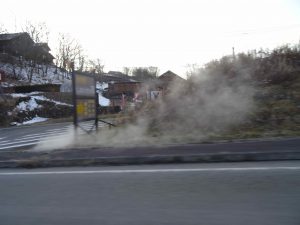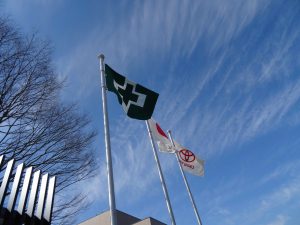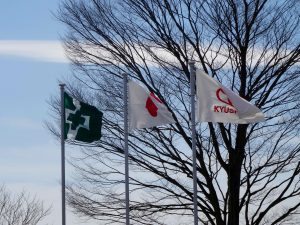We are spending a total of three weeks exploring Kyushu, Japan’s main southwest island, including the wonderful cities of Fukuoka and Nagasaki. Fukuoka has been ranked by some as the 7th most livable city in the world. Kyushu is one of Japan’s major four islands and one that is usually bypassed by most tourists, at least American tourists. Kyushu is filled with many natural wonders and landscapes including volcanoes. Shochu and onsens are also prevalent in Kyushu, adding to the relaxation factor!
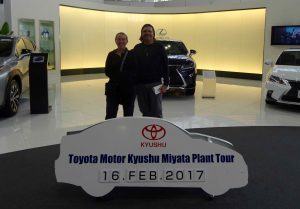
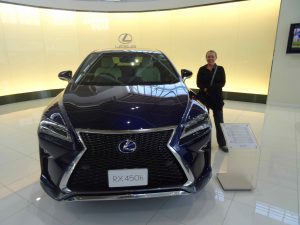 We leave Fukuoka, drive about 45 minutes north and make a stop for a tour of Toyota’s Kyushu Plant and the Toyota Production System (TPS).
We leave Fukuoka, drive about 45 minutes north and make a stop for a tour of Toyota’s Kyushu Plant and the Toyota Production System (TPS).
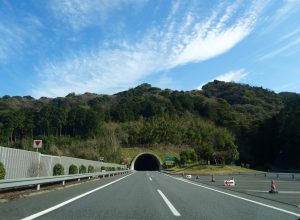 We are then on our way to explore the Mount Aso area, with the largest active volcano in Japan and the world’s second largest caldera with an active volcano.
We are then on our way to explore the Mount Aso area, with the largest active volcano in Japan and the world’s second largest caldera with an active volcano.
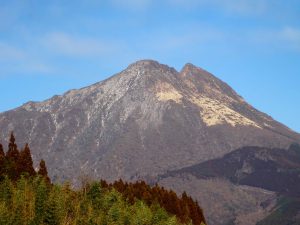 We are impressed by the mountains and countryside of Kyushu. The drive to the Mount Aso area is awesome with stunning views around the area. The volcanic area makes for impressive formations and peaks. The grasslands, even though brown this time of year are absolutely beautiful.
We are impressed by the mountains and countryside of Kyushu. The drive to the Mount Aso area is awesome with stunning views around the area. The volcanic area makes for impressive formations and peaks. The grasslands, even though brown this time of year are absolutely beautiful.
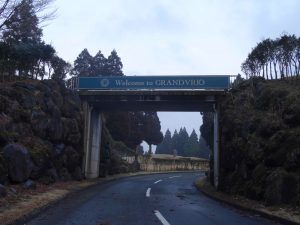
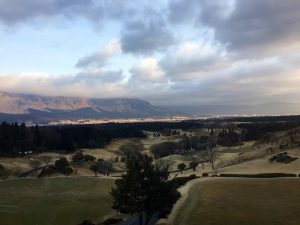 We are staying in the Mt. Aso area at an older resort, Mt Aso Grandvrio Hotel. That said, it does have an Arnold Palmer designed golf course. It is dotted with snow this time of year! There are even a few diehard golfers trying the course in the cold, rainy weather.
We are staying in the Mt. Aso area at an older resort, Mt Aso Grandvrio Hotel. That said, it does have an Arnold Palmer designed golf course. It is dotted with snow this time of year! There are even a few diehard golfers trying the course in the cold, rainy weather.
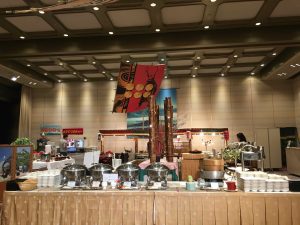 Our first night in the area we dine at the resort enjoying their buffet. Very impressive! Sushi, sashimi, crab legs, curry, tempura, ramen, beef loin, about everything! I sampled about everything, some items, twice.
Our first night in the area we dine at the resort enjoying their buffet. Very impressive! Sushi, sashimi, crab legs, curry, tempura, ramen, beef loin, about everything! I sampled about everything, some items, twice.
We went to check out the onsen here…the volcanic heated spa. Lots of rules but primarily no clothes on in the spa except for a washcloth that you put on top of your head. At this onsen men and women are separate but apparently this is not always the case. Looking forward to experiencing more of this tomorrow as I think it may be needed after our hike and a bit of touring in the area.
Friday
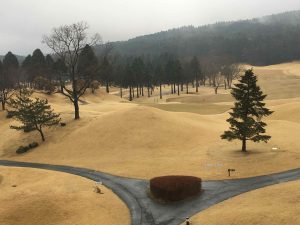 We wake up to rain and our first full day was a rainy one. The grass is a golden brown color and looking out over the golf course to the volcanic hills and domes is outstanding, even in the clouds.
We wake up to rain and our first full day was a rainy one. The grass is a golden brown color and looking out over the golf course to the volcanic hills and domes is outstanding, even in the clouds.
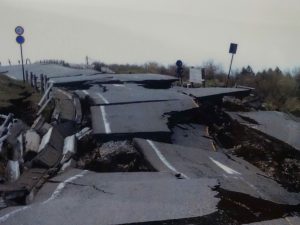
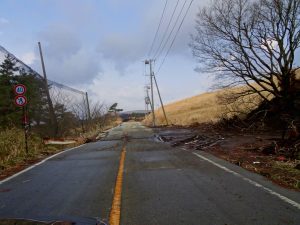 We do a bit of “work” in the morning then we go out for a ride in the caldera area. It looks like there are many homes with roof repair going on as well as roads closed and caving. It looks like there are “FEMA” homes here, too. I assume it is all a result over the recent eruptions the last couple of years.
We do a bit of “work” in the morning then we go out for a ride in the caldera area. It looks like there are many homes with roof repair going on as well as roads closed and caving. It looks like there are “FEMA” homes here, too. I assume it is all a result over the recent eruptions the last couple of years.
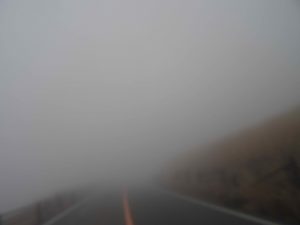
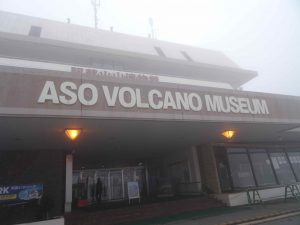 We drive toward the Aso Volcano Museum to see if we can make it before it closes. There is actually a beautiful large grassy area with a dome in the middle called Kusasenri that we are driving toward. But the fog is thick, as thick as I have ever driven in, even at night. It was day, so we decide to turn around, barely able to see headlights or taillights from the few passing cars.
We drive toward the Aso Volcano Museum to see if we can make it before it closes. There is actually a beautiful large grassy area with a dome in the middle called Kusasenri that we are driving toward. But the fog is thick, as thick as I have ever driven in, even at night. It was day, so we decide to turn around, barely able to see headlights or taillights from the few passing cars.
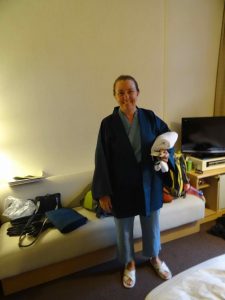 Instead, we head back to our hotel for our first trip to the onsen. We put on our Yakata, or robe. We actually look more like doctors in their scrubs as we head down. There are a few others enjoying these heated baths, but not crowded at all. The onsens are both inside and outside, those outside with great views of the mountains. And, of course, different than what we are used to in the US, all nude.
Instead, we head back to our hotel for our first trip to the onsen. We put on our Yakata, or robe. We actually look more like doctors in their scrubs as we head down. There are a few others enjoying these heated baths, but not crowded at all. The onsens are both inside and outside, those outside with great views of the mountains. And, of course, different than what we are used to in the US, all nude.
Saturday
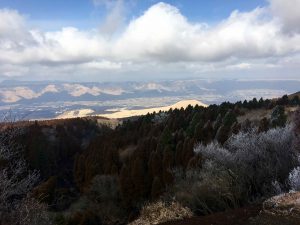
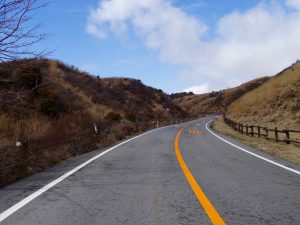 Wow, what a difference a day makes. As yesterday was all about heavy rain and warm temperatures, today is sunny, but cold! We head out again toward Mt. Aso and the Aso Volcano Museum, this time without the fog. The museum is worth a visit to learn a bit more about the volcanoes here and across Japan. Japan contains 7 percent of the world’s volcanoes.
Wow, what a difference a day makes. As yesterday was all about heavy rain and warm temperatures, today is sunny, but cold! We head out again toward Mt. Aso and the Aso Volcano Museum, this time without the fog. The museum is worth a visit to learn a bit more about the volcanoes here and across Japan. Japan contains 7 percent of the world’s volcanoes.
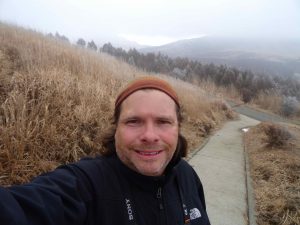
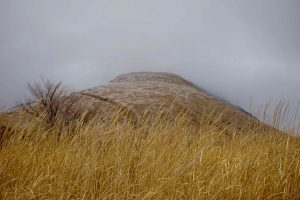 We take a couple of short hikes near the museum. From here there are some terrific views. The entire countryside and towns here sit in this massive caldera. The caldera stretches over 14 miles from north to south and over 10 miles from east to west. At the center of this grand caldera are five mountains of Aso – Mt. Nekodake, Mt. Takadake, Mt. Nakadake, Mt. Eboshidake, Mt. Kijimadake.
We take a couple of short hikes near the museum. From here there are some terrific views. The entire countryside and towns here sit in this massive caldera. The caldera stretches over 14 miles from north to south and over 10 miles from east to west. At the center of this grand caldera are five mountains of Aso – Mt. Nekodake, Mt. Takadake, Mt. Nakadake, Mt. Eboshidake, Mt. Kijimadake.
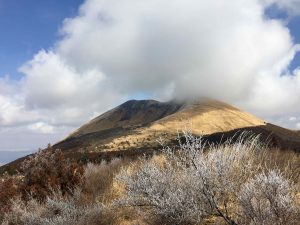 The morning is still a bit cold, but we hang in there. You can even see some of the moisture from the windchill freezing on the trees and bushes.
The morning is still a bit cold, but we hang in there. You can even see some of the moisture from the windchill freezing on the trees and bushes.
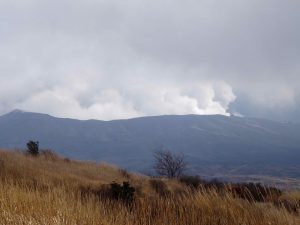
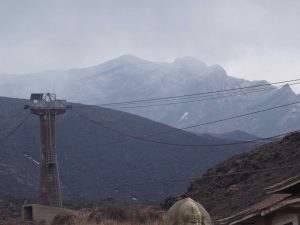 Mt. Nakadake is an active volcano emitting smoke which we see from the museum area. We drive up to what used to be a cable car that would take visitors near the rim for a peek inside the large crater. The “ropeway”, as they call them in Japan, was damaged by a major eruption in October 2016. There is a 2km restriction zone when we visit, as the volcano is still active and steaming. So no peak inside this crater, but still quite an awesome sight.
Mt. Nakadake is an active volcano emitting smoke which we see from the museum area. We drive up to what used to be a cable car that would take visitors near the rim for a peek inside the large crater. The “ropeway”, as they call them in Japan, was damaged by a major eruption in October 2016. There is a 2km restriction zone when we visit, as the volcano is still active and steaming. So no peak inside this crater, but still quite an awesome sight.
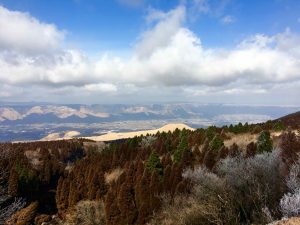
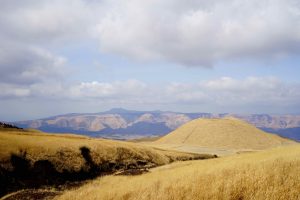 I think one of the most beautiful sites in this area is Mount Komezuka. In the winter and spring the grasses covering it are brown, almost a golden.
I think one of the most beautiful sites in this area is Mount Komezuka. In the winter and spring the grasses covering it are brown, almost a golden.
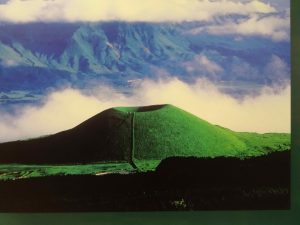 It is covered in a lush green in the summer time (picture borrowed from Aso Museum). Different, but both stunning.
It is covered in a lush green in the summer time (picture borrowed from Aso Museum). Different, but both stunning.
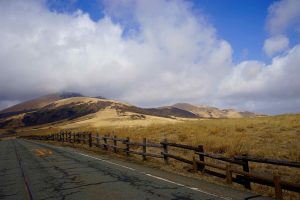
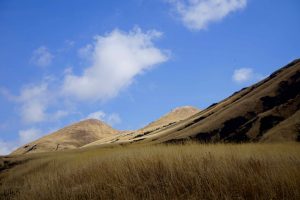 The skies grow clearer as our drive continues in the early afternoon. There are many simply amazing views and opportunities for some great photos.
The skies grow clearer as our drive continues in the early afternoon. There are many simply amazing views and opportunities for some great photos.
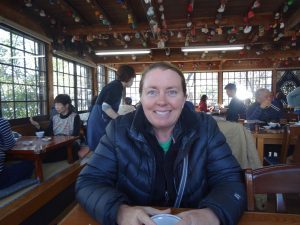
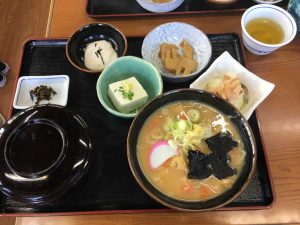 We stop for a terrific lunch at a small place in town, Sanzoku-Tabiji. This is a terrific place known for dangojiru (miso soup with thick-cut noodles) and takana ryōri (dishes using mustard greens). Not much english spoken here or any non-asian patrons, but we make out with a great lunch and friendly service.
We stop for a terrific lunch at a small place in town, Sanzoku-Tabiji. This is a terrific place known for dangojiru (miso soup with thick-cut noodles) and takana ryōri (dishes using mustard greens). Not much english spoken here or any non-asian patrons, but we make out with a great lunch and friendly service.
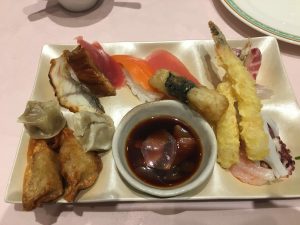 We head back to the resort for a relaxing afternoon. We have dinner again at the resort. Tonight’s dinner was very crowded with maybe three busloads of people from China or Taiwan. Most are in the same boat we are, that is all of us not speaking much Japanese! Many tourists enjoying this area!
We head back to the resort for a relaxing afternoon. We have dinner again at the resort. Tonight’s dinner was very crowded with maybe three busloads of people from China or Taiwan. Most are in the same boat we are, that is all of us not speaking much Japanese! Many tourists enjoying this area!
Sunday
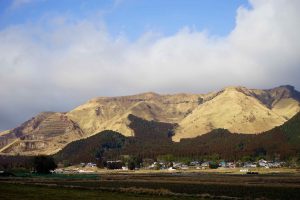
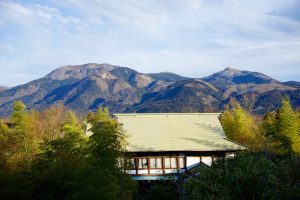 We are up early to catch breakfast and we are on our way to Takachiho Gorge by 9 AM. The distance as the crow flies in is not very far but we are traveling through the hills of the caldera and many winding roads.
We are up early to catch breakfast and we are on our way to Takachiho Gorge by 9 AM. The distance as the crow flies in is not very far but we are traveling through the hills of the caldera and many winding roads.
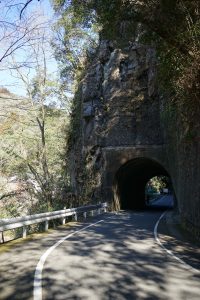
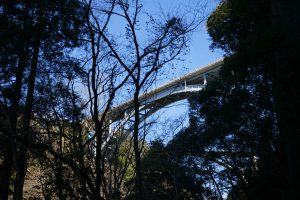 The drive is spectacular. There are many gorgeous bridges and tunnels. The formations of the hills surrounding us are amazing, obviously formed by volcanic activity.
The drive is spectacular. There are many gorgeous bridges and tunnels. The formations of the hills surrounding us are amazing, obviously formed by volcanic activity.
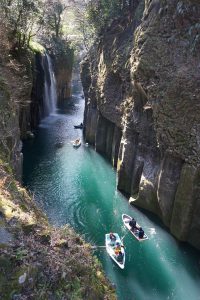 We arrive at the gorge around 10:30 AM. It is a beautiful, sunny day with temperatures probably in the 40s. There are quite a few people, but it is not overly crowded. There are some people enjoying rowboats on the river through the gorge. Several areas are inaccessible due to recent earthquake damage.
We arrive at the gorge around 10:30 AM. It is a beautiful, sunny day with temperatures probably in the 40s. There are quite a few people, but it is not overly crowded. There are some people enjoying rowboats on the river through the gorge. Several areas are inaccessible due to recent earthquake damage.
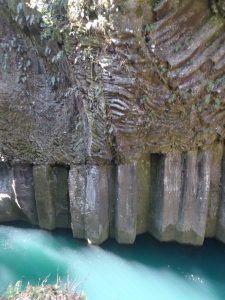 The gorge is not huge but what is more interesting are the formations from the lava flows over the centuries. The spectacular steep walls were formed by what is called “columnar jointing”, due to the rapid cooling of an ancient lava flow that filled the narrow valley of the Gokase River after an eruption of the Mt. Aso volcano. It is amazing to think how many miles away the impact of Mt. Aso has been felt.
The gorge is not huge but what is more interesting are the formations from the lava flows over the centuries. The spectacular steep walls were formed by what is called “columnar jointing”, due to the rapid cooling of an ancient lava flow that filled the narrow valley of the Gokase River after an eruption of the Mt. Aso volcano. It is amazing to think how many miles away the impact of Mt. Aso has been felt.
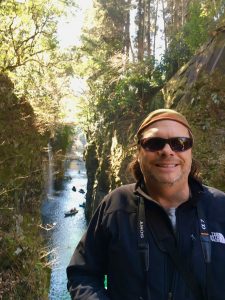
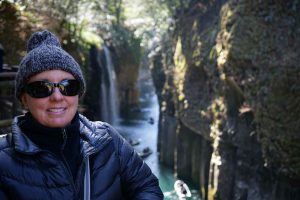 We have our first conversation in English at the gorge with a couple from Tokyo, that had lived for many years in Rhode Island. In the last few days, there has been very little English spoken in the areas we have been to. After spending about an hour or so at the gorge we are back on the road to take the southeast coast down to Kagoshima.
We have our first conversation in English at the gorge with a couple from Tokyo, that had lived for many years in Rhode Island. In the last few days, there has been very little English spoken in the areas we have been to. After spending about an hour or so at the gorge we are back on the road to take the southeast coast down to Kagoshima.
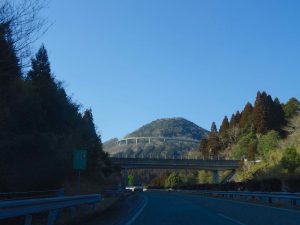 As we drive south we stop in an area just south of Miyazaki and make our way to a McDonald’s. It is around 2 pm on a Sunday and is very crowded. There are many children inside enjoying a Sunday afternoon with parents.
As we drive south we stop in an area just south of Miyazaki and make our way to a McDonald’s. It is around 2 pm on a Sunday and is very crowded. There are many children inside enjoying a Sunday afternoon with parents.
We basically order by pointing to the menu. I know enough to say one or two and we manage to get the order right. What is wonderful is the young lady taking our order wants to make sure we have a place to sit. So she leaves the counter and walks us around the corner to the seating area and seats us. I cannot remember the last time I had a hostess provide me with a reserved seat at a McDonalds.
Once seated the gentleman with his two boys next to us strikes up a brief conversation. His boys, around ten years old have just finished a karate lession. We make a “small” amount of small talk about our trip, the weather, where we are from and going. And this is the first time someone in Japan has mentioned “Trump”. He reminds us that we have a new president, lol. We point out that their Prime Minister Abe was just playing golf with Trump in Florida, our home state.
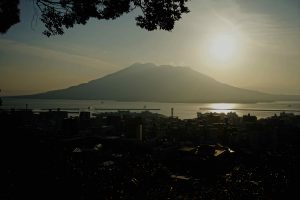 We arrive in Kagoshima at 4:30 pm. As we approach, we are greeted by a view of an enourmous volcano that lies within the very large Kagoshima Bay. The volcano, Sakurajima (桜島), is one of Japan’s most active volcanoes and seen as the symbol of Kagoshima. The volcano smokes constantly, and minor eruptions often take place, multiple times a day. The elevation of the volcano is over 3,600 feet with a circumference of about 30 miles!
We arrive in Kagoshima at 4:30 pm. As we approach, we are greeted by a view of an enourmous volcano that lies within the very large Kagoshima Bay. The volcano, Sakurajima (桜島), is one of Japan’s most active volcanoes and seen as the symbol of Kagoshima. The volcano smokes constantly, and minor eruptions often take place, multiple times a day. The elevation of the volcano is over 3,600 feet with a circumference of about 30 miles!
Before a powerful eruption in 1914, Sakurajima used to be an island in the bay, but the massive lava flow from that eruption created the volcano’s current land connection to the Osumi Peninsula in the east. The volcano is still most easily accessed by ferries that run the 3.5 kilometers between Kagoshima Port and the Sakurajima Ferry Terminal.
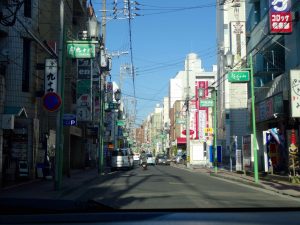
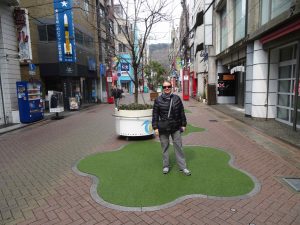 We are staying in the central area of Kagoshima. It is an area with streets lined with shops, restaurants, and hotels. Many of the streets are quite narrow.
We are staying in the central area of Kagoshima. It is an area with streets lined with shops, restaurants, and hotels. Many of the streets are quite narrow.
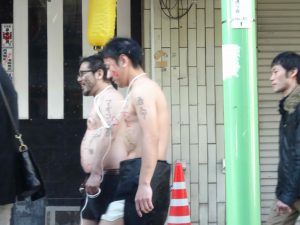 Pictured is one of the less sightly sites we see, but wish we had not, lol. Maybe this is going to be a fun, interesting place!
Pictured is one of the less sightly sites we see, but wish we had not, lol. Maybe this is going to be a fun, interesting place!
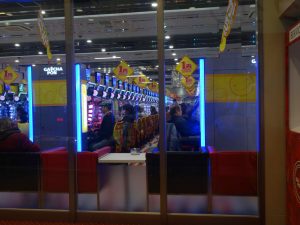 Just a block from our hotel are a few streets blocked for pedestrian use that also have pachinko centers, quite popular here in Japan. Pachinko is a game that originated in Japan in the 1920s and is used for “gambling” here.
Just a block from our hotel are a few streets blocked for pedestrian use that also have pachinko centers, quite popular here in Japan. Pachinko is a game that originated in Japan in the 1920s and is used for “gambling” here.
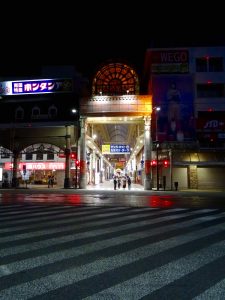 We head out for a Sunday night dinner in Kagoshima around 6:30 pm. I make an attempt to find a restaurant on Yelp, TripAdvisor and the rest of the Internet, but many of the reviews are in the Japanese alphabet.
We head out for a Sunday night dinner in Kagoshima around 6:30 pm. I make an attempt to find a restaurant on Yelp, TripAdvisor and the rest of the Internet, but many of the reviews are in the Japanese alphabet.
Anyway we end up wandering around a bit and fortunately come upon a small place that looks cozy, Wasou. It has one large table with six or eight young men eating, imbibing, talking and laughing. It is Sunday evening and they are all in their black suits. The “Sunday work” and black suits seem common in Japan!
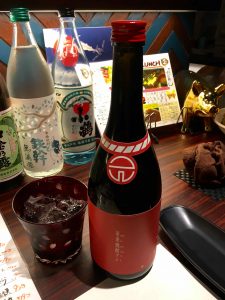 I try some of the Shochu on the rocks, which is sort of a potato vodka that each region of Japan makes and prides itself. The owner of Wasou tells me he helped make the particular selection I am drinking. Very good!
I try some of the Shochu on the rocks, which is sort of a potato vodka that each region of Japan makes and prides itself. The owner of Wasou tells me he helped make the particular selection I am drinking. Very good!
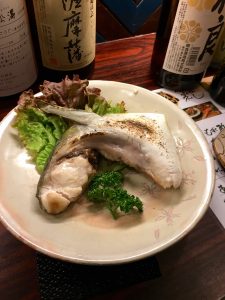
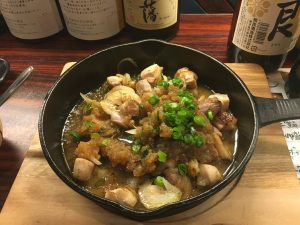 The food is excellent, from the fresh green salad, grilled collar of yellowtail, to the chicken teppanyaki, to the salted pork belly. The region prides itself in its food and in particular its black pork. Black pork, or Kurobuta, means “black hog” in Japanese. It is sort of like pork version of the high quality Waygu beef. It comes from the Black Berkshire pig, and is known as the highest quality pork in the world.
The food is excellent, from the fresh green salad, grilled collar of yellowtail, to the chicken teppanyaki, to the salted pork belly. The region prides itself in its food and in particular its black pork. Black pork, or Kurobuta, means “black hog” in Japanese. It is sort of like pork version of the high quality Waygu beef. It comes from the Black Berkshire pig, and is known as the highest quality pork in the world.
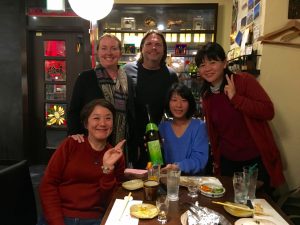
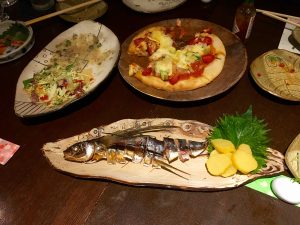 Just as our delicious pork dish arrives, a table of three wonderful ladies, Yoshie (Maya), Sumiko, and Ritsu, ask us where we are from and then ask us to join them! We spend the next two hours translating and talking, sharing food and drink. I try a Japanese whiskey that is terrific. Ritsu works at the distillary in Yakashima. She is a zymologist, a fermentation specialist! Yakashima is a subtropical island off the southern coast of Kyushu and part of Kagoshima Prefecture. It is covered by an extensive cedar forest that contains some of Japan‘s oldest living trees. Trees more than 1000 years old are affectionately called yakusugi (a combination of Yakushima and sugi, the Japanese word for cedar), the most ancient of which may be over 7000 years old. Unfortunately we will not make it here during our three month Japan visit 🙁 ).
Just as our delicious pork dish arrives, a table of three wonderful ladies, Yoshie (Maya), Sumiko, and Ritsu, ask us where we are from and then ask us to join them! We spend the next two hours translating and talking, sharing food and drink. I try a Japanese whiskey that is terrific. Ritsu works at the distillary in Yakashima. She is a zymologist, a fermentation specialist! Yakashima is a subtropical island off the southern coast of Kyushu and part of Kagoshima Prefecture. It is covered by an extensive cedar forest that contains some of Japan‘s oldest living trees. Trees more than 1000 years old are affectionately called yakusugi (a combination of Yakushima and sugi, the Japanese word for cedar), the most ancient of which may be over 7000 years old. Unfortunately we will not make it here during our three month Japan visit 🙁 ).
Our new friends have spent the day doing what we intend to do, hiking in the Kirishima volcanic area of Kagoshima. Shinmoedake is a volcano that recently became active. Up until a year or so ago, you were able to hike across the top of the volcano, now restrictions are about one km away.
These great times with wonderful local people are what make living around the world the best!
Monday Morning
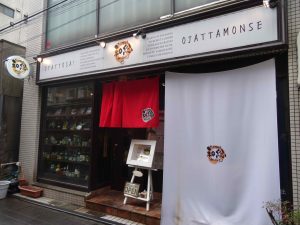
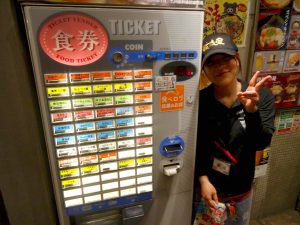 We wake up to clouds and rain is predicted most of the day. We head out for lunch to find some noodles and end up eating pork ramen and gyoza. When you walk into the restaurant, you place your own order at what looks like a vending machine. It spits out small paper tabs with your order on it. The entire menu and machine is in Japanese so we get assistance!
We wake up to clouds and rain is predicted most of the day. We head out for lunch to find some noodles and end up eating pork ramen and gyoza. When you walk into the restaurant, you place your own order at what looks like a vending machine. It spits out small paper tabs with your order on it. The entire menu and machine is in Japanese so we get assistance!
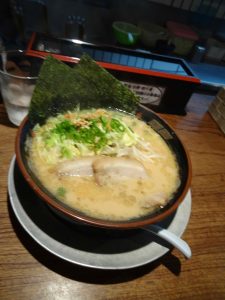
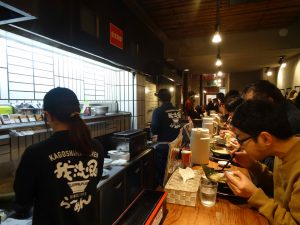 The food is delicious! The wonderful lady next to me helps me with how to eat my noodles, by placing them in the broth bowl instead of the other way around!
The food is delicious! The wonderful lady next to me helps me with how to eat my noodles, by placing them in the broth bowl instead of the other way around!
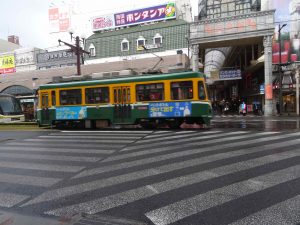 We wandered around the area for a bit, and head back to the hotel to relax.
We wandered around the area for a bit, and head back to the hotel to relax.
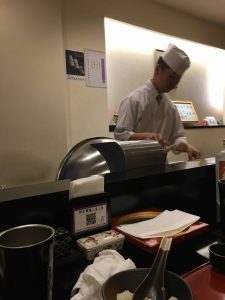
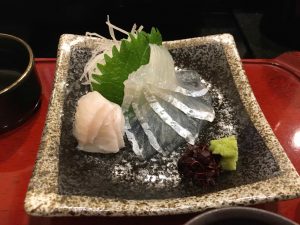 For dinner we head over to a tempura restaurant. The dinner was absolutely amazing. It was prepared by the chef right in front of us at the bar where we were seated. We have a variety of sashimi, including flounder and scallops along with anago (sea eel).
For dinner we head over to a tempura restaurant. The dinner was absolutely amazing. It was prepared by the chef right in front of us at the bar where we were seated. We have a variety of sashimi, including flounder and scallops along with anago (sea eel).
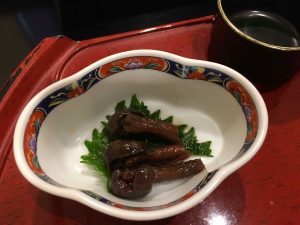
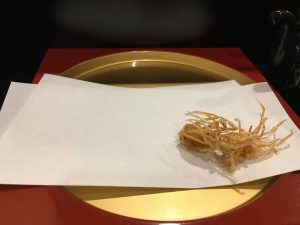 The tempura we try ranges from “Confucius liver” (still not sure what this is, lol), as well as pond smelt, garfish, shrimp legs and various vegetables.
The tempura we try ranges from “Confucius liver” (still not sure what this is, lol), as well as pond smelt, garfish, shrimp legs and various vegetables.
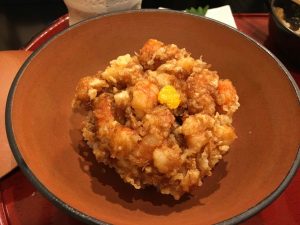 The final dish on the menu was tendon tempura. The chef and the waitress speak little English but they do well with their translation app!
The final dish on the menu was tendon tempura. The chef and the waitress speak little English but they do well with their translation app!
Tuesday
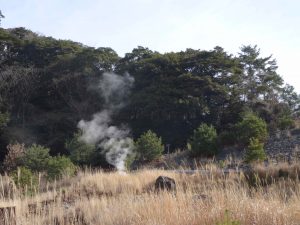
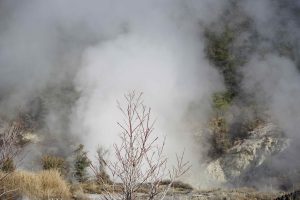 The rain cedes and we get a sunny morning. We head up to Kirishima to squeeze in a hike before we drive to Kumamoto for the night. The start of our hike is about 90 minutes north of Kagoshima. Once off the expressway we come through several mountain towns and villages. We start to see steam and smoke rising from the mountain areas. The smell of sulfur is thick in the air. It smells a bit like Florida, lol!
The rain cedes and we get a sunny morning. We head up to Kirishima to squeeze in a hike before we drive to Kumamoto for the night. The start of our hike is about 90 minutes north of Kagoshima. Once off the expressway we come through several mountain towns and villages. We start to see steam and smoke rising from the mountain areas. The smell of sulfur is thick in the air. It smells a bit like Florida, lol!
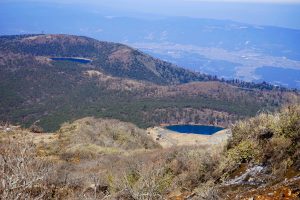
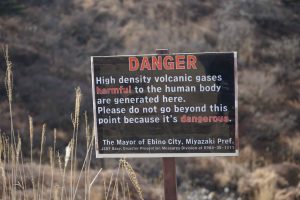 Kirishima is an active volcanic mountain range. The area has a beautiful volcanic landscape with numerous cones, craters and lakes.
Kirishima is an active volcanic mountain range. The area has a beautiful volcanic landscape with numerous cones, craters and lakes.
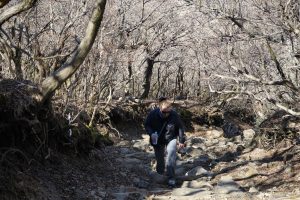
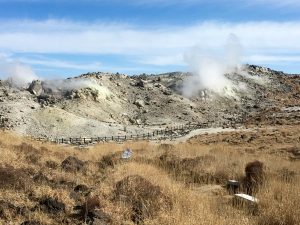 We leave the car park area at Ebino Kogen and start our 2.5 kilometer ascent to the summit of Mount Karakunidake. This is the highest peak in the area at 1700 meters. It is said that you can see Korea from here on a clear day. It is clear but a bit hazy, so no view of Korea today. However, the views are spectacular. Part of the area to our left is steaming and closed to hiking.
We leave the car park area at Ebino Kogen and start our 2.5 kilometer ascent to the summit of Mount Karakunidake. This is the highest peak in the area at 1700 meters. It is said that you can see Korea from here on a clear day. It is clear but a bit hazy, so no view of Korea today. However, the views are spectacular. Part of the area to our left is steaming and closed to hiking.
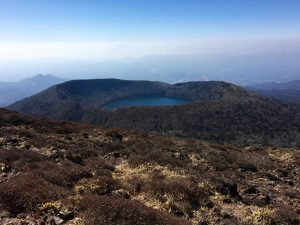 As we make the ascent we have 360 degree views of this awesome area. To our right or south in the distance we can see Sakurajima Volcano in Kagoshima Bay and closer, Lake Onami which we will hike to later in the morning.
As we make the ascent we have 360 degree views of this awesome area. To our right or south in the distance we can see Sakurajima Volcano in Kagoshima Bay and closer, Lake Onami which we will hike to later in the morning.
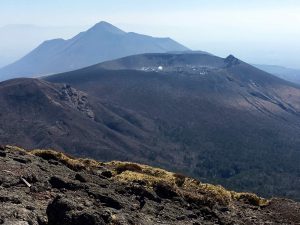
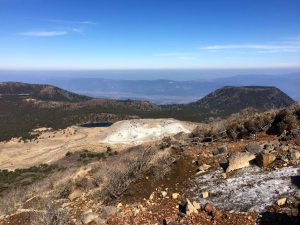 We also have great views of Mount Shinmoedake, another active volcano. Up until the 2011 eruption of Mount Shinmoedake, one was able to hike to this volcano. It had apparently not erupted for the previous 300 years. A no-entry zone is in place restricting access one kilometer from the crater. This closure includes the trail that passes the summit of Mount Shinmoedake.
We also have great views of Mount Shinmoedake, another active volcano. Up until the 2011 eruption of Mount Shinmoedake, one was able to hike to this volcano. It had apparently not erupted for the previous 300 years. A no-entry zone is in place restricting access one kilometer from the crater. This closure includes the trail that passes the summit of Mount Shinmoedake.
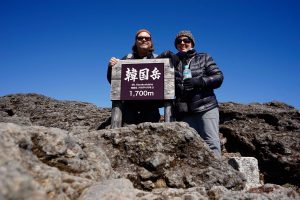
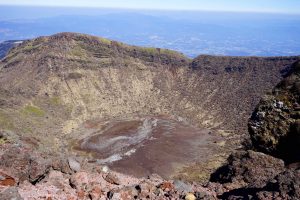 As we approach the summit of Mount Karakunidake we are right on schedule in about 90 minutes. We are able to walk to the edge and peer into this massive cone. Absolutely awesome. We hang out here for a bit and take some pictures of the surrounding area. There are only a couple of other hikers that we encounter, amazing for such a spectacular place.
As we approach the summit of Mount Karakunidake we are right on schedule in about 90 minutes. We are able to walk to the edge and peer into this massive cone. Absolutely awesome. We hang out here for a bit and take some pictures of the surrounding area. There are only a couple of other hikers that we encounter, amazing for such a spectacular place.
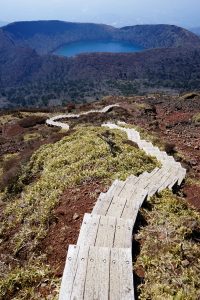
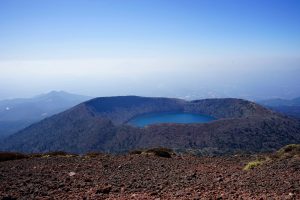
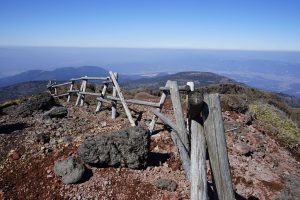 Onward, we hike down from the summit toward Lake Onami. The lake is located at an elevation of 1,412 meters, the highest crater lake in Japan. Our hike is 1.2 km with some steep, wet areas along the way. There are actually some stairs along the way but also a bit of mud and ice. We passed a couple of hikers along way, going up the mountain…not sure I would want to hike in that direction!
Onward, we hike down from the summit toward Lake Onami. The lake is located at an elevation of 1,412 meters, the highest crater lake in Japan. Our hike is 1.2 km with some steep, wet areas along the way. There are actually some stairs along the way but also a bit of mud and ice. We passed a couple of hikers along way, going up the mountain…not sure I would want to hike in that direction!
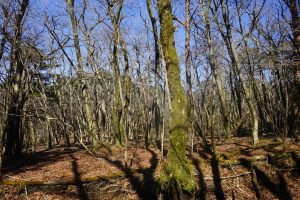 Once we reach the side of the lake, which is the side of the crater, we turn right to walk another 2.5 km through some streams and wooded areas, where we finally pick up our car. We finish the 6 km walk just before 3:00 PM.
Once we reach the side of the lake, which is the side of the crater, we turn right to walk another 2.5 km through some streams and wooded areas, where we finally pick up our car. We finish the 6 km walk just before 3:00 PM.
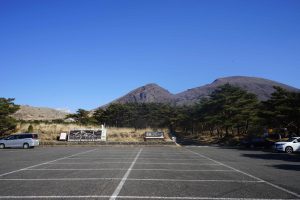 I am down to my last pair of shoes on the trip and at this point they are pretty muddy. We take off our muddy shoes. Tracey has another pair, I put on my flip-flops. Japan is probably one place in the world where it may not be too unusual to be wearing slippers in the winter!
I am down to my last pair of shoes on the trip and at this point they are pretty muddy. We take off our muddy shoes. Tracey has another pair, I put on my flip-flops. Japan is probably one place in the world where it may not be too unusual to be wearing slippers in the winter!
The drive out of this area is beautiful with windy roads through the hills and mountains and an occasional geo thermal area! We continue to drive through many tunnels used to traverse the mountains here in Kyushu.
We arrive in Kumamoto a couple of hours later for a one-night stay. Our hotel room has a perfect view of Kumamoto Castle.
Wednesday
We opt for the buffet breakfast at our hotel. It is a traditional Japanese breakfast with a wide variety! Delicious!
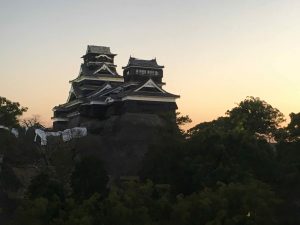 After breakfast we head out to view Kumamoto Castle, also known as ”Ginnnan Castle”. It is revered as one of the best castles of Japan. Construction of the castle began in 1601 by the regional lord, Kato Kiyomasa, and was completed seven years later. The castle premises are magnificent, approximately 9 kilometers in circumference, with large main towers, 49 turrets, and 29 entry gates.
After breakfast we head out to view Kumamoto Castle, also known as ”Ginnnan Castle”. It is revered as one of the best castles of Japan. Construction of the castle began in 1601 by the regional lord, Kato Kiyomasa, and was completed seven years later. The castle premises are magnificent, approximately 9 kilometers in circumference, with large main towers, 49 turrets, and 29 entry gates.
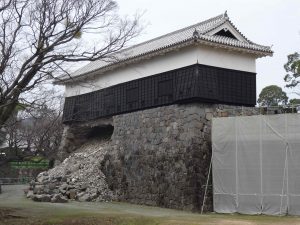 Unfortunately, there were a series of earthquakes in April 2016, including a major magnitude 7.0 quake. The quakes killed at least 50 people and injured about 3,000 others in total, with numerous structures collapsing and catching fire. Significant damage to the castle resulted. We see many of the castle’s stone walls that were damaged, collapsed and under repair. Total repairs to the castle will take years.
Unfortunately, there were a series of earthquakes in April 2016, including a major magnitude 7.0 quake. The quakes killed at least 50 people and injured about 3,000 others in total, with numerous structures collapsing and catching fire. Significant damage to the castle resulted. We see many of the castle’s stone walls that were damaged, collapsed and under repair. Total repairs to the castle will take years.
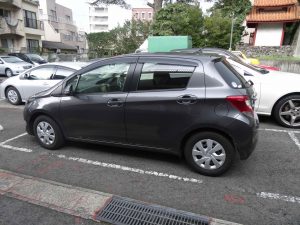 We are on the road around 11 AM. Our three-hour drive will take us to Nagasaki, the last stop on our tour of Kyushu!
We are on the road around 11 AM. Our three-hour drive will take us to Nagasaki, the last stop on our tour of Kyushu!
And a few more pics!
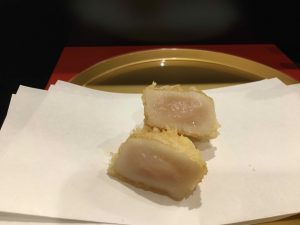
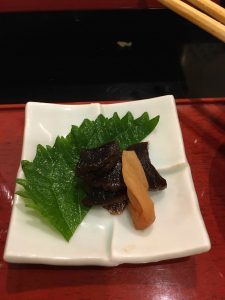
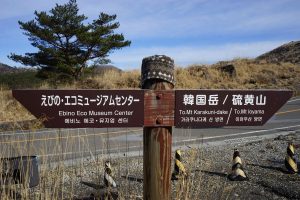
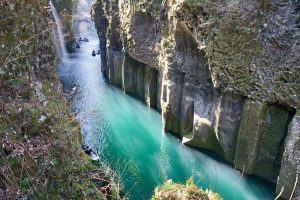
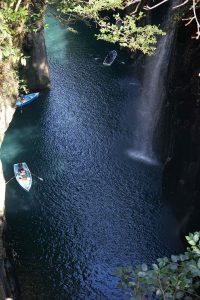
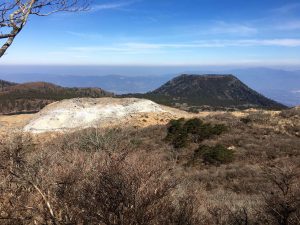
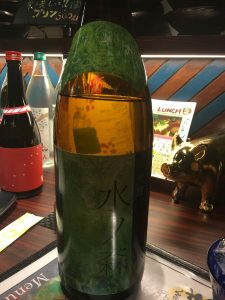
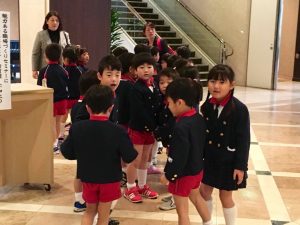
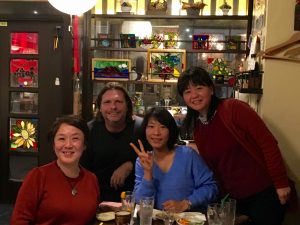
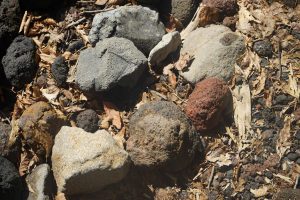
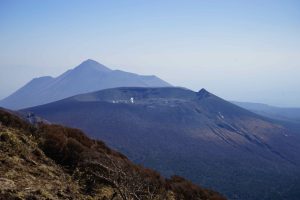
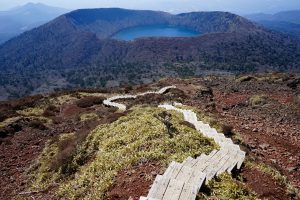
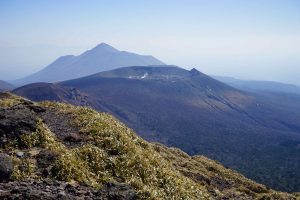
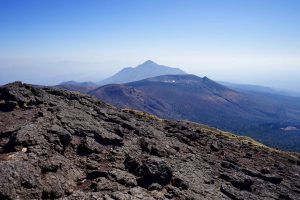
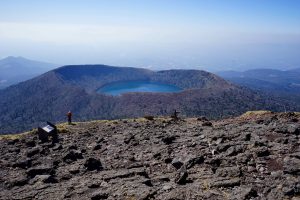
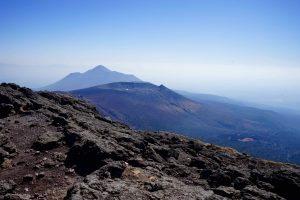
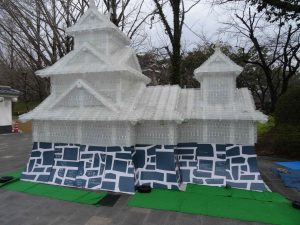
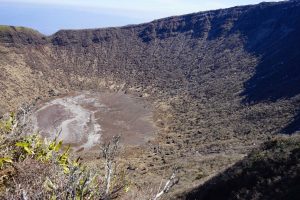
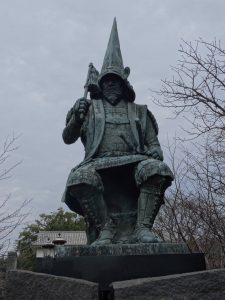

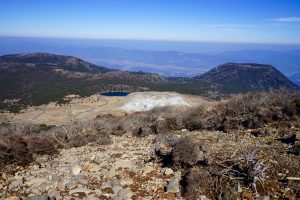
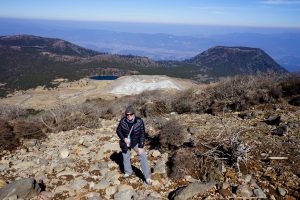
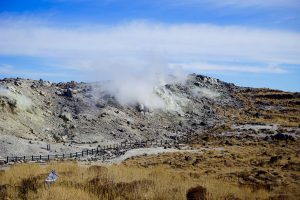

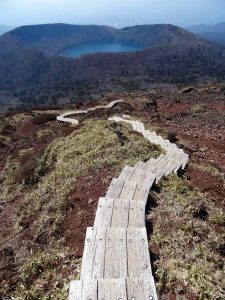
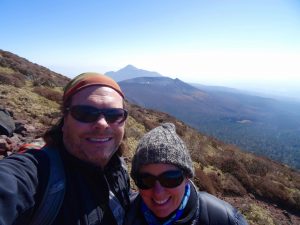
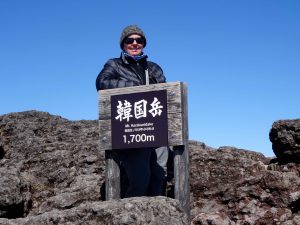
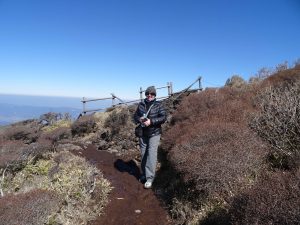
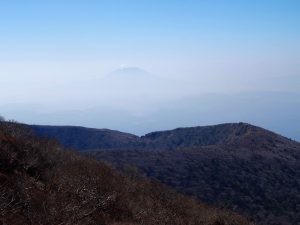
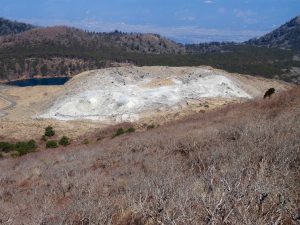
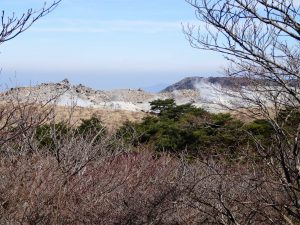
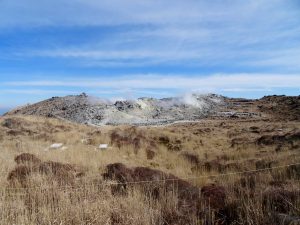
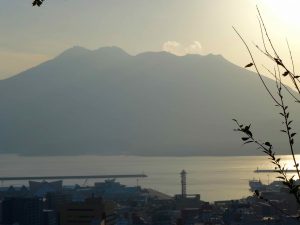
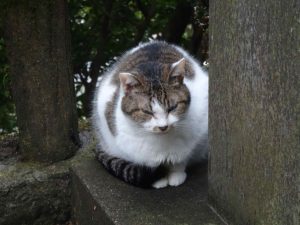
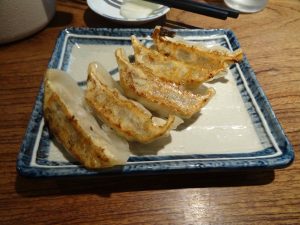
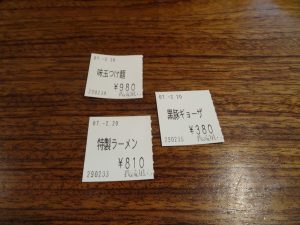
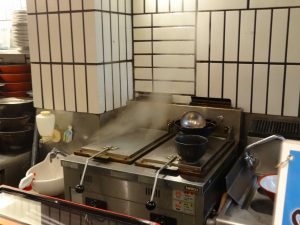
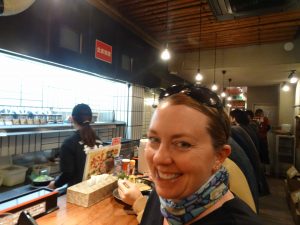


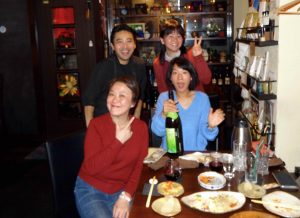
![]()
